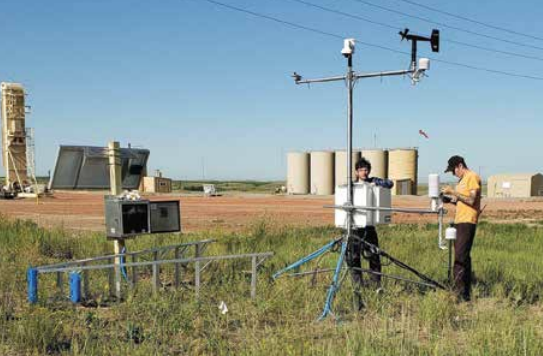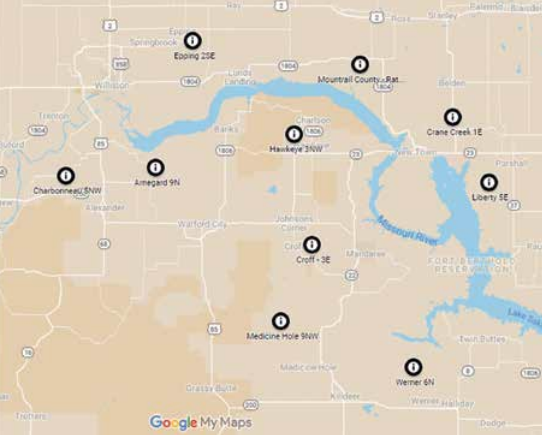Anyone who’s driven on gravel roads knows they can turn into a muddy mess when it rains. It’s tough for people who live on those roads, but it’s a real problem for oilfield truckers because weight restrictions are imposed and they’re shut down until conditions improve.

heaviest oilfield traffic. Seen here are NDAWN installers James Hyde and Alex Rushing at the Arnegard site.
The need to protect the roads from damage is understandable, but because heavy rainfall can be spotty, county highway managers have been known to impose weight restrictions where they’re not really necessary. Oilfield truckers naturally complain, but road managers can’t do much about it because it’s impossible to know the condition of all the hundreds of miles of roads in western North Dakota.

were sited adjacent to well pads, gas processing plants or other industry facilities.
That’s about to change, thanks to a project launched by the Western Dakota Energy Association (WDEA). Called Wise Roads (Weather Information System to Effectively Reduce Oilfield Delays and Disruption), WDEA is in the process of installing weather monitoring stations throughout the oil-producing counties to provide local governments with weather information, especially precipitation data, to help guide road restriction policy.
WDEA, which operates the LoadPass Permit system for the counties to manage the movement of oversize trucks, is partnering with the North Dakota Agricultural Weather Network (NDAWN) on the project. WDEA plans to install up to 50 weather stations throughout western North Dakota, effectively saturating areas with the heaviest oilfield traffic. The Wise Roads project kicked off in late June with the installation of the first 10 weather stations, all of which were sited adjacent to well pads, gas processing plants or other industry facilities. Plans call for installing 15 more stations this fall, and if a WDEA grant application to the state Oil & Gas Research Council is successful, another 25 stations will be scattered around the Bakken next spring and summer.
In addition to providing temperature and precipitation data, each station is equipped with a subsurface probe that measures soil moisture and temperature, which can guide decisions in the spring when frost law weight restrictions are imposed. Stations are also equipped with a digital camera that can be rotated 360-degrees. Because most of the stations are positioned along gravel roads, the cameras provide a current snapshot of the road’s condition. Another partner in the project is the Upper Great Plains Transportation Institute (UGPTI) which conducts research and provides road management and training services to counties. UGPTI will assist county road departments in evaluating weather data to ensure that personnel are trained to apply it to roadrestriction policies. UGPTI will also use Wise Roads subsurface soil temperature and moisture data to analyze the performance of road-building materials and possibly build a prediction model for the timing of spring load restrictions.
The project could pay huge dividends to North Dakota’s oil industry. If road restrictions are in place more than a couple days, oil companies can be forced to shut down wells because tanks fill up and trucks can’t get to the well pad to empty them. A shutdown can cost companies thousands of barrels of production, amounting to millions in lost revenue. Reducing road closures could save those millions, which also benefits the mineral royalty owners and the state’s taxpayers.

